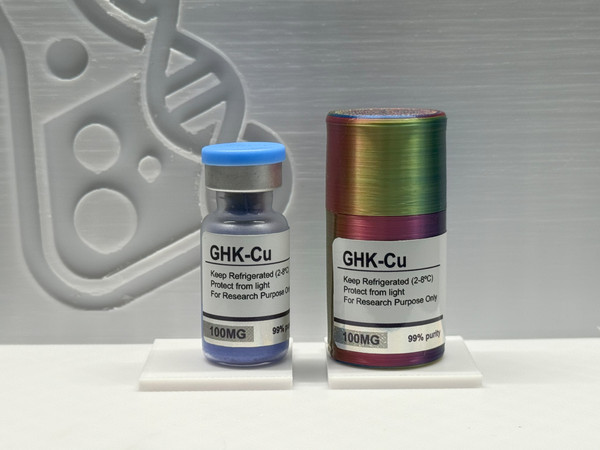Product Overview
Thanks for sharing this, Richard. Here's a Shopify-compliant rewrite of your GHK-Cu listing, structured under your established headings and refined to meet platform standards while preserving scientific clarity and operational professionalism:
? GHK-Cu – Research-Grade Copper Tripeptide for Cellular & Matrix Investigation
Synonyms: Glycyl-L-Histidyl-L-Lysine Copper Complex, Copper Tripeptide-1
CAS Number: 89030-95-5
Sequence: Gly-His-Lys·Cu²⁺
Molecular Weight: ~403.9 Da (complexed form)
Form: Lyophilized powder
Purity: ≥98% (HPLC)
Use: For laboratory research only. Not for human or veterinary use.
? Overview
GHK-Cu is a naturally occurring copper-binding tripeptide composed of glycine, histidine, and lysine, complexed with a divalent copper ion (Cu²⁺). It is endogenously present in plasma and other biological fluids, with concentrations known to decline with age.
In laboratory settings, GHK-Cu is under investigation for its role in extracellular matrix remodelling, antioxidant signalling, and cellular adaptation. Its compact structure and copper affinity make it suitable for in vitro and non-human model systems focused on regenerative biology.
⚙️ Mechanistic Insights
Preclinical studies suggest GHK-Cu may influence several biological pathways:
• Collagen & ECM Remodelling – May support synthesis of collagen, elastin, and glycosaminoglycans
• Cytokine Modulation – Associated with downregulation of TNF-α and IL-6 in select models
• Angiogenesis Support – Copper ion may contribute to vascular endothelial growth factor (VEGF) signalling
• Fibroblast Activation – Studied for its role in wound recovery and tissue integrity
• Neuronal Support – Investigated for effects on axonal guidance and synaptic plasticity
• Gene Expression Modulation – Explored for its impact on DNA repair and transcriptional activity
These findings are based on published scientific literature and are not indicative of human outcomes.
? Research Context
GHK-Cu is being evaluated in controlled laboratory environments for its relevance to:
• Extracellular matrix remodelling and fibroblast proliferation
• Skin and hair follicle biology
• Neuroinflammation and nerve signalling
• Bone remodelling and osteogenic assays
• UV exposure and oxidative stress models
All applications are strictly limited to research use and are not intended for therapeutic, diagnostic, or clinical purposes.
? Packaging & Storage
• Supplied as sterile-filtered lyophilized peptide–metal complex
• Store at –20°C, protected from light and moisture
• Reconstitute under sterile conditions using bacteriostatic water, saline, or appropriate buffer
• Refrigerate reconstituted solution at 2–8°C to preserve stability
Note: Solvent compatibility and formulation protocols are available upon request for qualified research institutions
⚠️ Compliance Notice
This product is intended strictly for laboratory research use. It is not approved for human or veterinary applications and must not be used in food, drugs, or cosmetics. All information is based on published scientific literature and is provided for educational and informational purposes only. Researchers are responsible for ensuring compliance with local laws and institutional guidelines.








